Did you know Americans eat nearly 12 billion ears of corn each year? That’s a huge number, showing how much we love this ingredient! In summer, corn on the cob is a favorite side dish. It brings people together at barbecues and picnics.
Learning to cook corn on the cob perfectly is an art. It makes every bite sweet and flavorful.
In this article, I’ll share my tips on cooking corn on the cob to perfection. You’ll learn how to pick the best ears and try different cooking methods. My advice will help you make your summer side dishes even better!
Key Takeaways
- Understand the importance of fresh corn for maximum flavor.
- Discover various cooking methods suitable for corn on the cob.
- Learn about popular toppings to enhance your corn experience.
- Be aware of common mistakes to avoid while cooking.
- Explore creative serving suggestions for corn on the cob.
Understanding Corn on the Cob
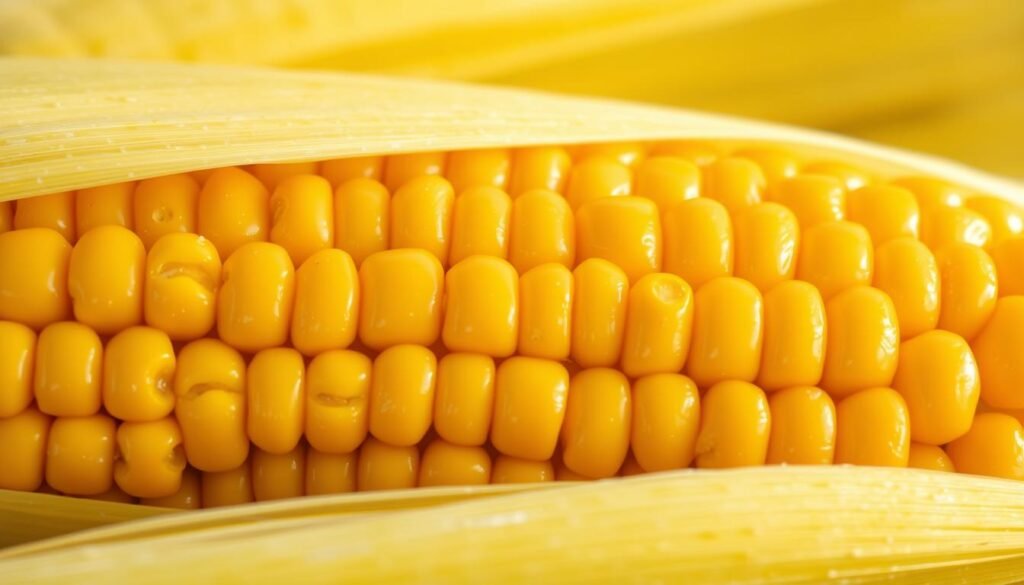
When summer comes, I think about corn on the cob. It’s a side dish made from whole ears of corn, cooked until tender and sweet. The flavor is rich and juicy, perfect for many meals.
What is Corn on the Cob?
Corn on the cob is the whole, raw ears of corn ready to eat. It’s a favorite during summer. The taste is amazing, and it’s a common dish in many American homes.
Nutritional Benefits of Corn
Corn is full of nutrients. It adds color and texture to my meals. It’s also high in dietary fiber, which helps with digestion.
Corn has vitamins A, C, and B vitamins, supporting health. It also has minerals like magnesium and potassium. Sweet corn, the most common type, is in season from May to September. It’s a great choice for nutritious meals.
| Nutrient | Amount per 100g |
|---|---|
| Calories | 86 |
| Protein | 3.2g |
| Carbohydrates | 19g |
| Dietary Fiber | 2.4g |
| Folate | 19µg |
| Vitamin C | 6.8mg |
| Magnesium | 37mg |
Types of Corn Suitable for Boiling
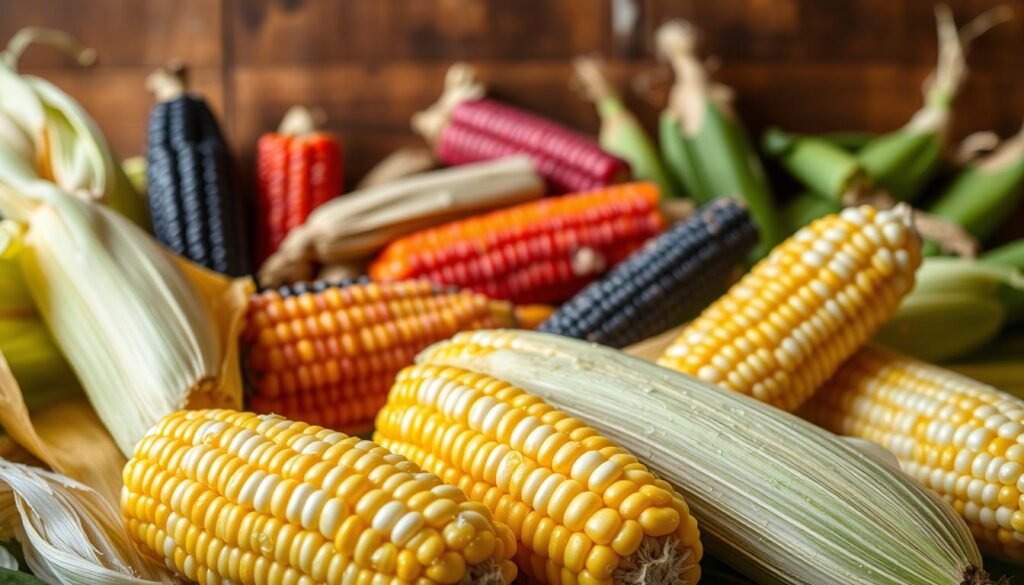
Choosing the right type of corn for boiling is key. Each type has its own flavor, texture, and taste. This affects how your meal turns out.
Sweet Corn
Sweet corn is the top pick for boiling. It’s full of natural sugars, making it tender and tasty. You can find it in yellow, white, and bicolor, adding variety to your meals.
Field Corn
Field corn is mainly used for animal feed and processing. It’s starchy and not as sweet as sweet corn. While it’s good for making cornmeal and syrup, it’s not the best for eating fresh.
Specialty Varieties
Specialty corns offer unique flavors and textures. Heirloom and purple corn can add excitement to your dishes. They let you get creative with corn on the cob.
| Type of Corn | Flavor Profile | Best Uses |
|---|---|---|
| Sweet Corn | Sweet and tender | Boiling, grilling, fresh eating |
| Field Corn | Starchy, less sweet | Animal feed, processed food products |
| Specialty Varieties | Varied; often unique | Creative dishes, gourmet meals |
Preparing Corn on the Cob
Preparing corn on the cob is a fun process that makes the experience even better. The first step is to pick fresh corn. The quality of the corn greatly affects the taste of your dish. So, choosing fresh corn is key.
Selecting Fresh Corn
I look at the husks when picking corn. Bright green husks mean it’s fresh. Yellowing husks suggest it might not be as good.
I also check if the kernels are plump and firm. This ensures I get the sweetest and juiciest corn for my meal.
Husk and Silk Removal
After picking the corn, I remove the husks and silk. I gently peel back the husks, being careful not to tear them. It’s important to get rid of all the silk strands clinging to the kernels.
A simple tug on the silk usually works well. This leaves the corn clean and ready for cooking.
Rinsing Techniques
After removing the husks and silk, I rinse the corn under cold water. This step gets rid of any remaining dirt or particles. Clean corn is essential for the best flavor and texture.
Cooking Methods for Corn on the Cob
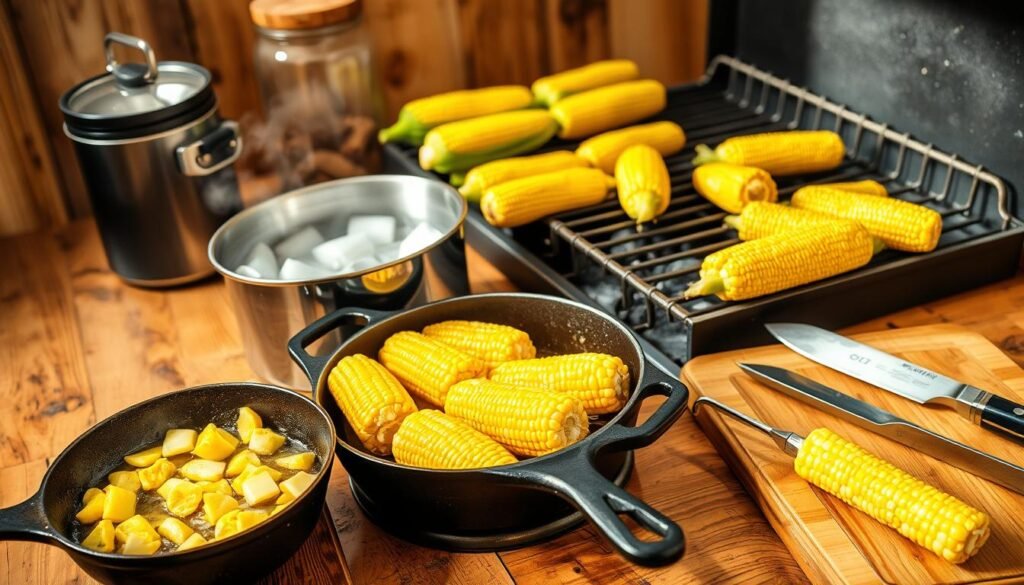
There are many ways to cook corn, each bringing out its sweet flavor and tender texture. Boiling, steaming, grilling, and roasting are some of the methods. Each offers a unique experience, making corn on the cob delicious in different ways.
Boiling Corn
Boiling corn is a popular choice. I start by boiling salted water, then add fresh corn. Cooking for 3-5 minutes makes the kernels tender and juicy. It’s quick and easy, perfect for fast meals.
Steaming Corn
Steaming is another great way to cook corn. I put the corn in a steamer basket over boiling water. This method keeps the corn’s color and nutrients while making it tender.
Grilling Corn
Grilling corn adds a smoky flavor. I grill it in its husk or directly on the grates for 10-15 minutes. The result is caramelized kernels with a unique taste that’s perfect for barbecues.
Roasting in the Oven
Roasting corn in the oven is cozy for cooler days. I wrap the corn in foil with butter and seasoning, then roast it for 20-25 minutes. It’s tender but might not have the charred taste of grilling.
Adding Flavor to Corn
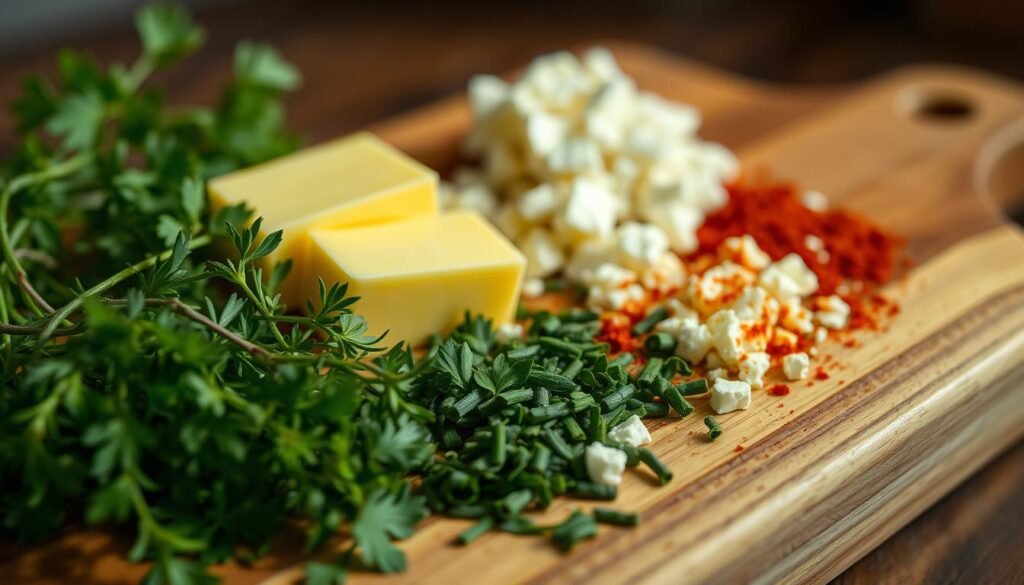
After cooking corn on the cob, I find that adding flavor can really make it better. There are many corn toppings to choose from, making each dish unique. Classic choices like melted butter, salt, and pepper are great, but there’s more to try.
Popular Toppings
- Melted butter
- Salt and black pepper
- Grated Parmesan cheese
- Chopped green onions
- Cilantro or chives
Herb and Spice Suggestions
I enjoy trying out different herbs and spices to make corn taste better. Some of my favorites are:
- Smoked paprika
- Chili powder
- Cumin
- Garlic powder
Sauces and Dips
Exploring corn sauces and dips opens up even more options. I often choose:
- Chipotle sauce for a smoky kick
- Vegan ranch dressing for a creamy twist
- Lime vinaigrette for a refreshing touch
By mixing these toppings, herbs, spices, and sauces, I can make corn on the cob my own. This way, every bite is full of flavor, making it even more enjoyable.
Timing is Everything
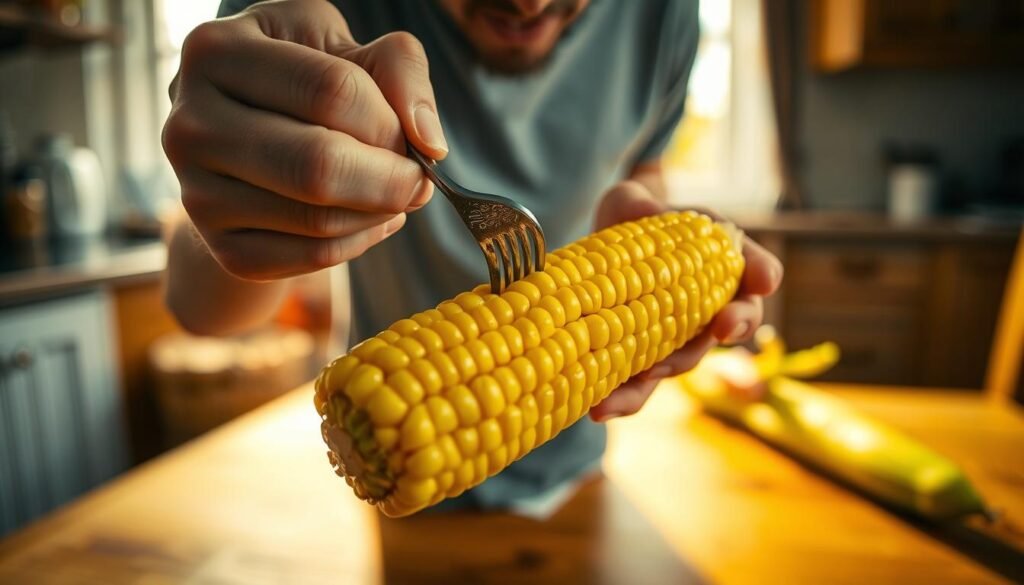
Timing is key when cooking corn. Each method has its own cooking time. Knowing how long to cook corn is crucial for the best taste and texture.
Following the right cooking time makes corn juicy and tender. It also boosts the flavor.
Cooking Time Based on Method
Boiling corn on the cob takes 3-5 minutes. Steaming or grilling might take longer but adds a smoky taste. Choose your method based on what you like.
| Cooking Method | Cooking Time |
|---|---|
| Boiling | 3-5 minutes |
| Steaming | 5-7 minutes |
| Grilling | 10-15 minutes |
| Oven Roasting | 20-30 minutes |
How to Check for Doneness
Checking if corn is done is easy. Look for bright yellow kernels that are tender but still crisp. A quick taste will tell you if it’s ready.
If you’re not sure, use a guide like cooking times for corn. It helps ensure your corn turns out perfectly.
Safety Tips for Cooking Corn
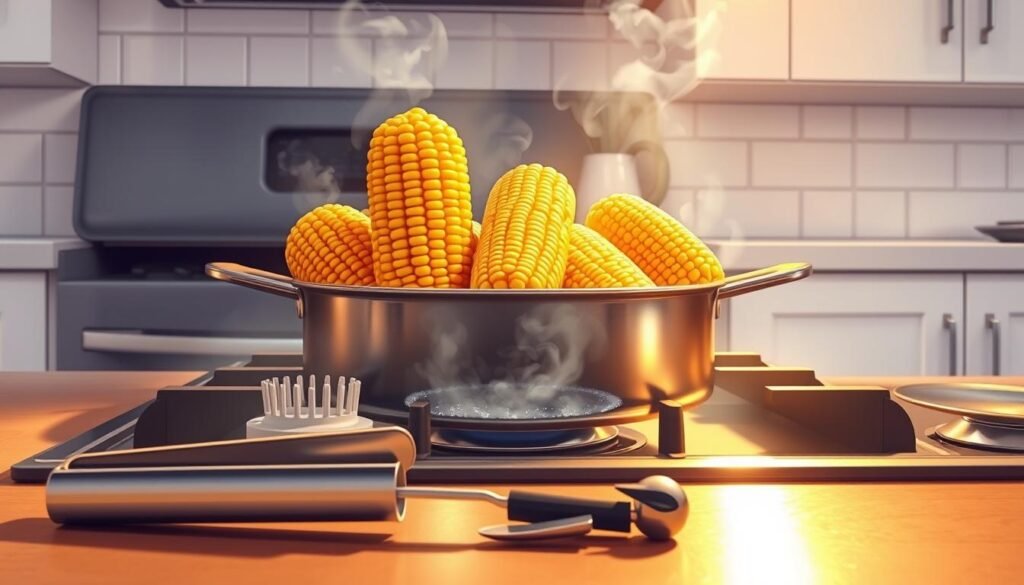
Cooking corn on the cob is fun, but safety is key. Knowing how to handle hot corn and store leftovers is important. It makes the experience enjoyable.
Handling Hot Corn
When I cook corn, I use tongs or corn holders to avoid burns. It’s easy to forget how hot corn can be after boiling or grilling. So, be careful and let it cool a bit before serving.
Proper Storage of Leftovers
Uneaten corn needs careful handling. I cool leftovers before storing them in an airtight container. This keeps the corn fresh and safe to eat. Storing leftovers properly helps me enjoy cooked corn for 3-5 days.
Serving Suggestions for Corn on the Cob
There are many ways to serve corn on the cob. It’s great with different meals, perfect for barbecues and summer parties. The trick is to find the best pairings to make your meal special.
Perfect Pairings
Corn goes well with grilled meats like steaks and chicken in tangy sauce. It’s also good with smoky ribs or pulled pork. For a lighter choice, try it with summer salads of fresh greens, tomatoes, and cucumbers.
Adding salsa or creamy avocado dip makes it even better. This mix of flavors is exciting and delicious.
Creative Serving Ideas
Try cutting corn off the cob for salads or salsas. It looks great and is easy to eat. You can also put corn on skewers for a fun look at your next party.
Don’t be afraid to add toppings like feta cheese, lime juice, or chili seasoning. These can make your corn even tastier, adding new flavors to every bite.
Common Mistakes When Cooking Corn
Cooking corn on the cob can be a delightful experience. But, several common mistakes can ruin the dish. Knowing these pitfalls can improve your cooking skills and make the corn taste better.
Overcooking Issues
One big mistake is overcooking corn. If I leave it in boiling water too long, the kernels get mushy and lose their taste. The trick is timing.
Corn should cook for 4 to 7 minutes in boiling water. This way, I keep its juicy texture and crunchy bite. It makes the dish enjoyable.
Choosing the Wrong Type of Corn
Another mistake is picking the wrong type of corn. Using field corn instead of sweet corn can be disappointing. Sweet corn is sweeter and tenderer, perfect for boiling.
Knowing the right corn for your cooking method is key for great taste.
Fun Facts about Corn
Corn is more than just a staple food; it’s a key part of culture and agriculture. I enjoy learning about corn fun facts that show its historical importance and wide variety. This grain has greatly influenced diets and economies in many places, showing its lasting value.
Historical Significance
Corn’s history goes back thousands of years to ancient times. Indigenous peoples in the Americas grew corn, making it their main food. It was crucial for agriculture, trade, and cultural exchange.
When European settlers came to the New World, they saw corn’s worth. They took it to other parts of the world. The change from its wild ancestor, teosinte, to the many corn types today shows its adaptability and importance in history.
Varieties of Corn Across the World
The world has an amazing variety of corn, each for different uses. Here are some notable ones:
| Type of Corn | Description | Common Uses |
|---|---|---|
| Sweet Corn | Known for its high sugar content and tenderness | Boiled, grilled, or canned |
| Dent Corn | Characterized by a dent on the top of each kernel | Animal feed and processed foods |
| Flint Corn | Hard outer shell, often colorful | Popcorn and cornmeal |
| Waxy Corn | Contains a high level of amylopectin | Used in industrial food products |
| Blue Corn | A traditional variety with a blue kernel | Used for tortillas and cereals |
These corn types show its versatility in cooking and its big role in cultures worldwide. I’m always amazed by how corn shapes our food and traditions.
Corn on the Cob in Popular Culture
Corn on the cob is a symbol of summer and fun in movies and TV. You see characters enjoying it at picnics, barbecues, and fairs. It shows how much we value togetherness and simple joys.
Corn festivals are also key in celebrating this food. They include corn mazes and fairs that unite communities. These events have cooking contests and live shows, showing corn’s role in culture and traditions.
Want to learn more about corn’s role in history? Check out its importance in culinary history here. Corn brings people together through movies and festivals, sharing tasty moments.
FAQ
Choose corn with bright green husks and plump, firm kernels. The silk should be moist, not dry.
Steaming corn keeps its sweetness. It’s a great choice if you don’t want to boil it.
Yes, grilling in the husk adds flavor and keeps kernels moist. Soak the corn first to prevent burning.
Boil for 3-5 minutes. It’s done when kernels turn bright yellow and are tender but crisp.
Try melted butter, salt, and pepper. For more flavor, use compound butter, fresh herbs, and spices.
Refrigerate corn after cooking. If left out over two hours, it’s safer to throw it away.
Look for bright yellow kernels that are tender yet crisp. A taste test can also confirm doneness.
Sweet corn is high in sugar and eaten fresh. Field corn is for animal feed and processing.
Yes! Store cooked corn in an airtight container in the fridge for 3-5 days. It’s great in salads or salsas.
Cut corn off the cob for salads. Use skewers for easy eating. Try it with different dips and sauces for extra flavor.
